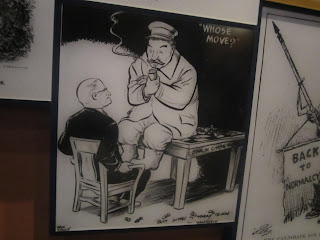Oil painting, according to the Wikipedia page is: "
...the process of painting with pigments that are bound with a medium of drying oil—especially in early modern Europe, linseed oil."
Before researching, I'm going to guess what this means:
Oil painting is when you paint with pigments (the colors you use that are made up of manmade chemicals or naturally occurring chemicals) that are bound with a medium of drying oil (after you paint, you put a coating on it so the colors don't run and they stay in place).
What I know about oil painting/physical make-up of oil paint:
-In the olden days, some colors were worth more than gold (ex. Lapis Lazuli...it was mentioned in the sistine chapel packet)
-Some colors were harmful to breathe in, therefore paint with
-There were/are cheap shades of colors and more expensive versions
-Crushed up berries, shells etc. are some natural forms of pigments
-Apparently some paints can function as medicine and vice versa (also mentioned in the sistine chapel packet)
Terms...
...I'm confident that I know (from the list we got on the sheet):
Opacity- How transparent/strong a color appears to be. The stronger the opacity, the more intense the color is. The weaker the opacity, the more transparent/faint a color is. (I know this more from digital art from using layers)
Art Dictionary definition: The power of a pigment to cover or obscure the surface to which it is applied (values from 99%-1%).
Student Grade vs. Artist Grade- Materials that students use (cheaper quality, but good to use to experiment with things), and that professional artists use (better quality, but more expensive and not as open to experimentation...because of how much it costs)
Art Dictionary definition:
Drying Times- How long it takes paint/whatever medium you're using to dry.
Art Dictionary/web definition: Traditional oil paints are bound with drying oils. This makes them much slower drying than water-based media. Drying times depend on how the paint is layered.
http://www.winsornewton.com/resource-centre/product-articles/article-drying-times-for-oil-paint/
Varnishes- A protective coating that gives a shiny look to whatever it covers
Art Dictionary definition: A protective transparent finish applied in a liquid state to a surface. Many are available with a matte, semi-gloss or glossy finish.
Pigment- The chemicals (naturally occuring or synthetic) that produce colors that can be used to paint with.
Art Dictionary definition: Finely powdered color material which produces the color of any medium. Made either from natural substances or synthetically, pigment becomespaint, ink, or dye when mixed with oil, water or another fluid (also called vehicle). When pressed into wax it becomes a crayon, pencil or chalk.
Natural Pigments- Pigments made of naturally occurring materials (ex. Berries, shells, plants)
Art Dictionary definition: Naturally occurring pigments such as ochres and iron oxides
Synthetic Pigments- Pigments made of man-made materials (ex. Chemicals that are similar to the chemical make up in naturally occurring pigments)
Art Dictionary definition: Pigments that are manufactured or refined from naturally occurring materials (can be a cheaper alternative to more expensive naturally occurring pigments ex. lapis lazuli)
...That sound familiar (defined with artdictionary/regular dictionary):
Hues-A particular gradation of color; a shade or tint. The property of colors by which they can be perceived as ranging from red through yellow, green, and blue, as determined by the dominant wavelength of light.
True Pigments- (Pigments made of a single type of material/pigments producing the true color?????)
Thinners- A liquid mixed with paint or varnish to reduce its viscosity and make it easier to apply
Mediums- The material or technique used by an artist to produce a work of art. (Can also refer to what carries a paint's pigments can be called a vehicle/base)
Water Mixable/Miscible Oil Paints (WMO's)- A modern variety of paint that can be thinned or cleaned up with water (safer to use water than turpentine to clean up)
Pigment Load- The amount of pigment in a paint, compared to the amount of binder and other ingredients.
May also refer to the maximum amount of pigments or other solids that can be added to a paint and still form a strong, stable film.
http://www.goldenpaints.com/technicaldata/glossary.php
...That I don't know at all:
Vehicle/Binder- What carries a paint's pigments. It determines what kind of paint is produced.
Linseed Oil- A binder that produces oil paint. A drying oil that's commonly used because it dries to the most durable film.
Poppyseed Oil- A drying oil.
Stand Oil- Oil generated by heating linseed oil at high temperatures for a few days with the comlete absence of air. Highly viscous and can give highsly uniform coatings that can "dry" to more elastic coatings than normal linseed oil. Less prone to yellowing than normal linseed oil. (However, the rags with linseed oil are prone to
spontaneously combusting)
Walnut Oil- One of the most important oils used by Renaissance painters. It has short drying time and lacks a yellow tint. Good for base thinner and brush cleaner.
However, the paint film it produces is considered by some to be inferior to that of linseed oil.
http://en.wikipedia.org/wiki/Walnut_oil
Fat over Lean- The technique of applying paint with a higher oil ("fat") to pigment ratio over paint with a lower oil to pigment ratio ("lean") to ensure stable pain film. (Done to avoid cracked and less durable paint film.)


